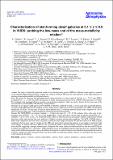Por favor, use este identificador para citar o enlazar a este item:
http://hdl.handle.net/10261/151864COMPARTIR / EXPORTAR:
 SHARE SHARE
 CORE
BASE CORE
BASE
|
|
| Visualizar otros formatos: MARC | Dublin Core | RDF | ORE | MODS | METS | DIDL | DATACITE | |

| Título: | Characterization of star-forming dwarf galaxies at 0.1 less than or similar to z less than or similar to 0.9 in VUDS: probing the low-mass end of the mass-metallicity relation |
Autor: | Calabro, A.; Pérez Montero, Enrique ; Zucca, E. | Palabras clave: | Galaxies: abundances Galaxies: dwarf Galaxies: evolution Galaxies: High-redshift Galaxies: Starburst |
Fecha de publicación: | 10-may-2017 | Editor: | EDP Sciences | Citación: | Astronomy & Astrophysics 601(A95): 1-27 (2017) | Resumen: | Context. The study of statistically significant samples of star-forming dwarf galaxies (SFDGs) at different cosmic epochs is essential for the detailed understanding of galaxy assembly and chemical evolution. However, the main properties of this large population of galaxies at intermediate redshift are still poorly known. Aims. We present the discovery and spectrophotometric characterization of a large sample of 164 faint (iAB ∼ 23-25 mag) SFDGs at redshift 0.13 ≤ z ≤ 0:88 selected by the presence of bright optical emission lines in the VIMOS Ultra Deep Survey (VUDS). We investigate their integrated physical properties and ionization conditions, which are used to discuss the low-mass end of the mass-metallicity relation (MZR) and other key scaling relations. Methods. We use optical VUDS spectra in the COSMOS, VVDS-02h, and ECDF-S fields, as well as deep multi-wavelength photometry that includes HST-ACS F814W imaging, to derive stellar masses, extinction-corrected star-formation rates (SFR), and gas-phase metallicities of SFDGs. For the latter, we use the direct method and a Te-consistent approach based on the comparison of a set of observed emission lines ratios with the predictions of detailed photoionization models. Results. The VUDS SFDGs are compact (median re ∼ 1.2 kpc), low-mass (M∗ ∼ 107-109 M⊙) galaxies with a wide range of starformation rates (SFR(Hα) ∼ 10-3-101 M⊙/yr) and morphologies. Overall, they show a broad range of subsolar metallicities (12 + log(O/H) = 7:26-8:7; 0.04 ≲ Z=Z⊙ ≲ 1). Nearly half of the sample are extreme emission-line galaxies (EELGs) characterized by high equivalent widths and emission line ratios indicative of higher excitation and ionization conditions. The MZR of SFDGs shows a flatter slope compared to previous studies of galaxies in the same mass range and redshift. We find the scatter of the MZR is partly explained in the low mass range by varying specific SFRs and gas fractions amongst the galaxies in our sample. In agreement with recent studies, we find the subclass of EELGs to be systematically oset to lower metallicity compared to SFDGs at a given stellar mass and SFR, suggesting a younger starburst phase. Compared with simple chemical evolution models we find that most SFDGs do not follow the predictions of a "closed-box" model, but those from a gas-regulating model in which gas flows are considered. While strong stellar feedback may produce large-scale outflows favoring the cessation of vigorous star formation and promoting the removal of metals, younger and more metal-poor dwarfs may have recently accreted large amounts of fresh, very metal-poor gas, that is used to fuel current star formation. © 2017 ESO. | Descripción: | Calabro, A. et. al. | Versión del editor: | http://dx.doi.org/ 10.1051/0004-6361/201629762 | URI: | http://hdl.handle.net/10261/151864 | DOI: | 10.1051/0004-6361/201629762 | ISSN: | 1432-0746 |
| Aparece en las colecciones: | (IAA) Artículos |
Ficheros en este ítem:
| Fichero | Descripción | Tamaño | Formato | |
|---|---|---|---|---|
| IAA_2017_aa29762-16.pdf | 4,3 MB | Adobe PDF |  Visualizar/Abrir |
CORE Recommender
SCOPUSTM
Citations
33
checked on 11-abr-2024
WEB OF SCIENCETM
Citations
30
checked on 28-feb-2024
Page view(s)
255
checked on 19-abr-2024
Download(s)
220
checked on 19-abr-2024
Google ScholarTM
Check
Altmetric
Altmetric
NOTA: Los ítems de Digital.CSIC están protegidos por copyright, con todos los derechos reservados, a menos que se indique lo contrario.
